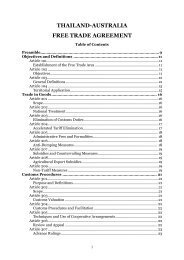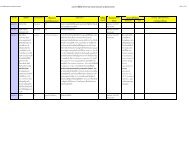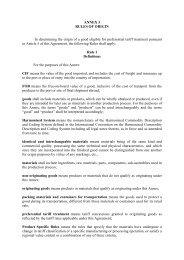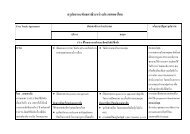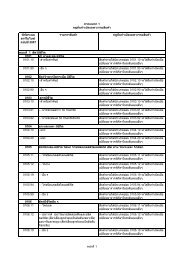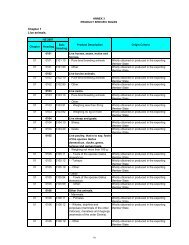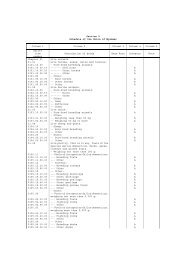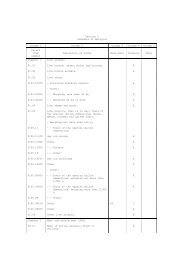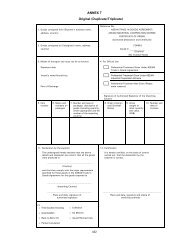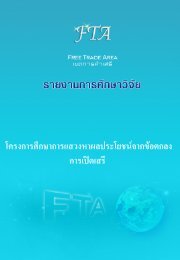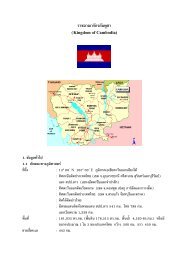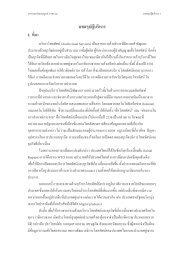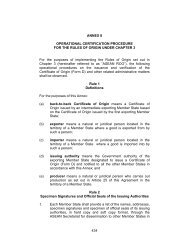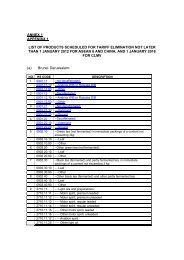International Standard Industrial Classification of All Economic ...
International Standard Industrial Classification of All Economic ...
International Standard Industrial Classification of All Economic ...
- No tags were found...
Create successful ePaper yourself
Turn your PDF publications into a flip-book with our unique Google optimized e-Paper software.
Introduction 29<br />
however, business units that sell goods and supply services exclusively through the<br />
Internet are coming into existence. Such units should also be classified to the industry<br />
<strong>of</strong> their principal activity. Production units engaged in e-commerce will therefore be<br />
found in any industry <strong>of</strong> ISIC. There is one notable exception to this rule: in retail<br />
trade, units that undertake their sales exclusively or predominantly through the Internet<br />
are classified within ISIC, Rev.4 class 4791 (Retail sale via mail order houses or via<br />
Internet).<br />
4. Repair and maintenance<br />
135. ISIC, Rev.4 now provides separate categories for the repair <strong>of</strong> all kinds <strong>of</strong><br />
goods. However, no single high-level category exists that would cover all repair activities.<br />
Based on the type <strong>of</strong> good repaired, the activities are classified as follows:<br />
• Repair <strong>of</strong> motor vehicles and <strong>of</strong> motorcycles are classified in classes 4520 and<br />
4540, respectively.<br />
• Repair <strong>of</strong> computers and communication equipment is classified in group<br />
951.<br />
• Repair <strong>of</strong> personal and household goods is classified in group 952.<br />
• Repair <strong>of</strong> other machinery and equipment is classified in group 331.<br />
• Repair <strong>of</strong> buildings and other structures is classified in division 43.<br />
5. Outsourcing / activities on a fee or contract basis<br />
136. In some cases, units sell goods or services under their own name but the<br />
actual production, such as the physical transformation process in the case <strong>of</strong> manufacturing,<br />
is carried out fully or in part by others through specific contractual arrangements.<br />
This section describes how units involved in such arrangements should be<br />
classified in ISIC.<br />
137. In this section, the following terminology is applied:<br />
(a) The principal 16 is a unit that enters in a contractual relationship with<br />
another unit (here called contractor) to carry out some part (or all) <strong>of</strong> the production<br />
process;<br />
(b) The contractor 17 is a unit that carries out a specific production process<br />
based on a contractual relationship with a principal. The activities performed by the<br />
contractor are denominated “on a fee or contract basis”.<br />
(c) Outsourcing is a contractual agreement according to which the principal<br />
requires the contractor to carry out a specific production process. The term “subcontracting”<br />
is sometimes used as well. 18 In this context, the production process also<br />
includes supporting activities.<br />
138. The principal and the contractor may be located in the same economic<br />
territory or in different economic territories. The actual location does not affect the<br />
classification <strong>of</strong> either one <strong>of</strong> these units.<br />
(a)<br />
<strong>Classification</strong> <strong>of</strong> the contractor<br />
139. Contractors, i.e., units carrying out an activity on a fee or contract basis,<br />
are usually classified in the same ISIC category as units producing the same goods or<br />
services for their own account. Exceptions to this rule exist for trade activities, for<br />
which separate categories for such outsourced activities exist.<br />
16 Elsewhere sometimes known as<br />
“contractor” or “converter”.<br />
17 Elsewhere sometimes known as<br />
the “subcontractor”.<br />
18 Elsewhere, the terminology <strong>of</strong><br />
“insourcing” and “outsourcing”<br />
(referring to relationships<br />
between units involved) or<br />
“<strong>of</strong>fshoring” (referring to<br />
transactions between economic<br />
territories) may be used; those<br />
distinctions have no bearing on<br />
the guidelines in this section<br />
and are not used here.



